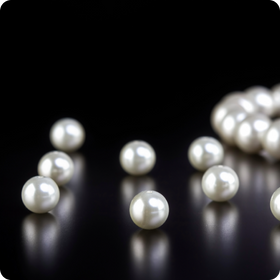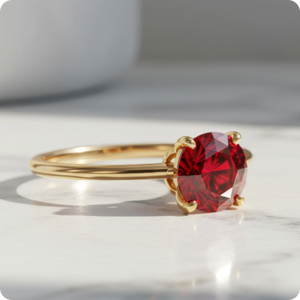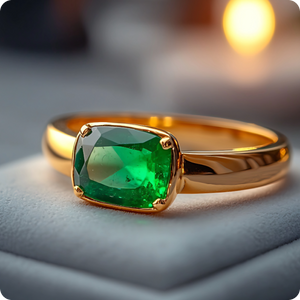It is often seen whenever we think of a Yellow Sapphire or a Pukhraj gemstone, we imagine a flawless golden crystal which is radiant, clear, and pure. However, the reality of a genuine and pure Pukhraj is far more intricate and captivating. You can see that every natural yellow sapphire has tiny internal characteristics which are known as inclusions. Mostly people consider these inclusions as imperfections of the stone, but they are way beyond that, those inclusions are the sign of gemstone’s authenticity, natural origin along with its astrological power.
In this blog we will be talking about the golden truth of yellow sapphire which includes all the inclusions. This blog will have an in-depth study about what these inclusions are, why these matter, and most importantly how these inclusions influence the beauty, value, and credibility of the gemstone.
What are Inclusions in Yellow Sapphire?
It is extremely rare to see a perfect yellow sapphire or any sapphire for that matter. If you see one, then that would certainly make a whole in your pocket. On the other hand, the majority of high-quality natural Pukhraj stones have certain number of inclusions which is verified by the gemmologist to be a proof of authenticity of the gemstone.
Now these inclusions could be of various ways which includes appearance as crystals, feathers, lines, or clouds within the stone. Specifically, in the case of yellow sapphire these tiny inclusions are a proof of the stone’s natural origin.
These inclusions are important because each one tells a different story about the stone. With these inclusions you get to know about the heat, pressure, and the geological transformation that the sapphire has gone through over the years.
Types of Yellow Sapphire Inclusions
Since it is now understandable that each inclusion gives a different story, hence, this is how the buyers and collectors are able to differentiate between a natural, treated, and synthetic stone. Below are some common yellow sapphire inclusions that could be found in a genuine Pukhraj stone:
Fingerprint Inclusion
These are the thin and curved patterns which is similar to a human fingerprint. These type of inclusions are formed when liquid or gas is filles in the cavities of the stone to heal them during the crystallisation process. Although, fingerprint inclusions are a definite indicator of the stone’s natural origin.
Needles and Rutile Silk
Rutile, a titanium oxide mineral is responsible for the fine needle-like inclusions within the sapphire stone. Rutile creates a soft silky effect within the stone. These silk inclusions are found even in the premium quality stones which helps in enhancing lustre of stone and keeps it balanced.
Crystals and Mineral Inclusions
Pukhraj gemstone authenticity can be identified through the tiny, embedded crystals of minerals alike zircon or spinel. When natural Pukhraj have these kinds of crystallisation, it helps the gemmologists and collectors to identify its origin.
Feathers
Feather inclusion as the name suggests looks like a white or a transparent wispy line in the gemstone. Even though this inclusion might look tiny or minimal, excessive feathering in the gemstone can weaken the stone’s structure. On the other hand, light feather inclusions are natural and harmless in terms of appearance and durability.
Growth Zoning
Growth zoning is a type of inclusion where there are faint colour bands or lines running through the gemstone. This inclusion indicates that the gemstone has been developed in layers over a period of time. This is usually seen in untreated sapphires which is a clear indication of genuine formation of the gemstone.
Liquid and Gas Inclusions
Another typical feature is tiny fluid or gas-filled bubbles or cavities. Since manufactured or heat-treated sapphires frequently lack these imperfections, they are especially crucial for distinguishing real stones.
Why Inclusions in Yellow Sapphire Matter?
There is a viable reason why inclusions in yellow sapphire matters because even though certain buyers associate these inclusions with defect, gemstone experts view them as clues for origin. here are some reasons why these inclusions play a significant role:
Proof of Authenticity
Like every fingerprint is different for every person, likewise these inclusions segregate these stones. These inclusions give a clear picture that the stone is natural and not lab grown. Usually the flawless, glassy, bubble-free Pukhraj at a reasonable price is questionable because either they have gone through heavy treatment or are synthetic.
Indicator of Treatment
Inclusions in yellow sapphire are also an indicator of the heat treatment or glass-filling used on the gemstone. For example, if the rutile silk appears to be melted or distorted then it is a clear indication of heat treatment to the gemstone. These things indicate Pukhraj gemstone authenticity and decide its market value.
Insight into Origin
Specific inclusions in yellow sapphire are also an indicator to the specific mines it has been extracted from. For example, a Sri Lankan Pukhraj has needle-like rutile silk whereas a yellow sapphire from Madagascar might show crystal inclusions.
Natural Beauty and Character
Each Yellow Sapphire has a distinct individuality thanks to inclusions. They give each diamond its own character, like a fingerprint in the artwork of nature. These inclusions can even improve the gem's depth and radiance if they don't impede transparency or brightness.
Inclusions and Pukhraj Gemstone Authenticity
For a gemmologist it is quite simple to identify the Pukhraj gemstone authenticity. They usually use the magnification technique to closely look at the inclusions, herein, a natural yellow sapphire would showcase internal features that are of the geological formation. A synthetic or a treated stone on the other hand, shows artificial patterns or residues.
Some of the indicators for checking authenticity of the gemstone are as follows:
- Natural fluid inclusions indicating unheated origin.
- Unbroken rutile silk suggesting no heat treatment.
- Presence of growth lines confirming natural crystallization.
- Absence of gas bubbles or surface residues seen in glass-filled stones.
To examine these characteristics, certified gemologists employ instruments including spectroscopy, polariscopes, and microscopes. This helps guarantee that the Pukhraj you purchase is neither a substantially modified gemstone or a lab copy.
How Inclusions Affect Yellow Sapphire Value
A delicate balance between clarity, colour, cut, and carat determines the market value of yellow sapphire. This is how inclusions are used:
- Minimal Inclusions: Rare and costly stones have extremely few inclusions and exceptional transparency.
- Visible but Balanced Inclusions: In premium natural stones, minor inclusions that don't compromise durability or brightness are allowed.
- Excessive Inclusions: Although they still have astrological importance if left untreated and natural, too many inclusions can dull appearance, impair clarity, and lower value.
It's interesting to note that astrologers frequently suggest unheated, untreated stones because they are thought to be more potent and purer in energy, even if they include impurities.
Inclusions in Natural vs Treated Yellow Sapphire
It is often seen that gem dealers use heat treatment for yellow sapphires for improving its colour and clarity. Even though this process enhances the visual appeal of the stone, but it alters these natural structure of inclusions.
Here is a comparison of inclusions to help identify such treatments:
|
Feature |
Natural Yellow Sapphire |
Heat-Treated/ Enhanced Sapphire |
|
Rutile Silk |
Intact, fine, evenly spread |
Melted or partially dissolved |
|
Crystals |
Clear, natural shape |
May appear cracked or distorted |
|
Colour Zoning |
Often visible |
Usually eliminated by heat |
|
Feathers |
Soft and natural |
Can appear flattened |
|
Bubbles |
Present naturally |
Absent or replaced by glass residues |
People seeking optimum astrological benefits are referred unheated and natural stones with natural inclusions. These are always preferred.
How to Check Yellow Sapphire Inclusions Before Buying
Knowing how to recognise inclusions can help you avoid being duped when buying a Pukhraj. What you can do is as follows:
Ask for a Gemmological Certificate
Always ask a reputable lab, such as GIA, IGI, or GRS, for certification. The report will specify whether the gemstones are synthetic, heated, or natural.
Examine Under a Loupe
To see inclusions, use a microscope or a 10x jeweler's loupe. While synthetic inclusions frequently have a regular or unnatural appearance, natural inclusions seem haphazard and organic.
Check for Heat Treatment Signs
The stone is frequently heated if it has melted silk or is extremely clean inside. Even small visible inclusions will always be present in a natural stone.
Verify Transparency
While a total lack of inclusions should also raise suspicions of synthetic origin, excessive inclusions may diminish transparency.
Buy from Trusted Sellers
Buy only from reputable gemstone vendors who offer authenticity certificates and disclose all treatments.
Astrological Perspective on Inclusions
According to astrology, a gemstone's potency is derived from its inherent energy vibrations. Jupiter, the planet of riches and knowledge, is linked to yellow sapphire. The stone needs to be natural and untreated in order to efficiently transfer Jupiter's energy.
According to astrologers, inclusions do not obstruct the beneficial energy of the diamond unless they are very opaque or dense. Conversely, they can function as indicators of genuineness, guaranteeing that the wearer obtains true advantages from the planet. Therefore, small imperfections in Yellow Sapphire are very acceptable from an astrological perspective.
Conclusion
The truth about Yellow Sapphire inclusions is obvious: they are natural indicators of authenticity and provenance rather than defects. The Earth's workmanship, millions of years of formation, and untainted vitality are all reflected in a true Pukhraj with delicate inclusions.
Look at the surface perfection the next time you admire a yellow sapphire. A Pukhraj gemstone's inclusions the golden truth that attests to its genuineness, purity, and strength are what give it its true beauty.
Always give natural, unheated, and certified stones top priority when purchasing a yellow sapphire for astrological or personal reasons. Recall that inclusions are nature's guarantee that your Pukhraj is genuine, strong, and genuinely unique; they are not flaws.
FAQs
1. Are inclusions in yellow sapphire a bad thing?
Not at all. Natural characteristics that develop during the formation of Yellow Sapphire are called inclusions. In fact, they aid in establishing the genuineness of the stone. A perfect Pukhraj is typically artificial or overly processed.
2. How can I tell if my pukhraj gemstone is real or fake?
Obtaining a gemological certificate from a reputable lab, such as GIA or IGI, is the simplest method. While imitation Pukhraj stones appear overly pristine or sparkling, natural ones typically have tiny imperfections.
3. Do inclusions affect the astrological power of yellow sapphire?
The energy or astrological potency of a stone is unaffected by little imperfections. The Pukhraj must be natural, untreated, and free of fissures that obstruct the flow of light or energy.
4. Why are some yellow sapphires heated or treated?
The purpose of heat treatment is to enhance colour and clarity, however it alters the inclusions' inherent structure. Astrologers love and value untreated stones with natural inclusions.
5. What type of inclusions should I look for in a genuine yellow sapphire?
Look for growth lines, fingerprint-like patterns, or tiny rutile needles (silk). These indicate a natural origin. Stones that are entirely transparent or have obvious glassy patches should be avoided since they have probably been treated.

 Emerald (Panna)
Emerald (Panna)
 Ruby (Manik)
Ruby (Manik)
 Yellow Sapphire (Pukhraj)
Yellow Sapphire (Pukhraj)
 Blue Sapphire (Neelam)
Blue Sapphire (Neelam)
 White Sapphire (Safed Pukhraj)
White Sapphire (Safed Pukhraj)
 Hessonite (Gomed)
Hessonite (Gomed)
 Red Coral (Moonga)
Red Coral (Moonga)
 Pearl (Moti)
Pearl (Moti)
 Cats Eye (Lahsuniya)
Cats Eye (Lahsuniya)
 Opal (Dudhiya Pathar)
Opal (Dudhiya Pathar)
 Red Garnet (Rakt Mani)
Red Garnet (Rakt Mani)
 Moonstone (Chandrakant)
Moonstone (Chandrakant)
 Carnelian (Rat-Ratua)
Carnelian (Rat-Ratua)
 Peridot (Mani Stone)
Peridot (Mani Stone)
 Green Onyx (Sulemani)
Green Onyx (Sulemani)
 Jade (Crassula)
Jade (Crassula)
 Citrine (Sunela)
Citrine (Sunela)
 Amethyst (Jamunia)
Amethyst (Jamunia)
 Aries (Mesh)
Aries (Mesh)
 Taurus (Vrushabh)
Taurus (Vrushabh)
 Gemini (Mithun)
Gemini (Mithun)
 Cancer (Kark)
Cancer (Kark)
 Leo (Sinh)
Leo (Sinh)
 Virgo (Kanya)
Virgo (Kanya)
 Libra (Tula)
Libra (Tula)
 Scorpio (Vrishchik)
Scorpio (Vrishchik)
 Sagittarius (Dhanu)
Sagittarius (Dhanu)
 January Birthstone
January Birthstone
 February Birthstone
February Birthstone
 March Birthstone
March Birthstone
 April Birthstone
April Birthstone
 May Birthstone
May Birthstone
 June Birthstone
June Birthstone
 July Birthstone
July Birthstone
 August Birthstone
August Birthstone
 September Birthstone
September Birthstone
 October Birthstone
October Birthstone
 November Birthstone
November Birthstone
 December Birthstone
December Birthstone

 Emerald Rings
Emerald Rings
 Yellow Sapphire Rings
Yellow Sapphire Rings
 Blue Sapphire Rings
Blue Sapphire Rings
 Ruby Rings
Ruby Rings
 Red Coral Rings
Red Coral Rings
 Pearl Ring
Pearl Ring
 White Sapphire Ring
White Sapphire Ring
 Amethyst Ring
Amethyst Ring
 Aquamarine Ring
Aquamarine Ring
 Blue Topaz Ring
Blue Topaz Ring
 Silver Jewellery
Silver Jewellery
 Gold Jewellery
Gold Jewellery
 Panchdhatu Jewellery
Panchdhatu Jewellery
 Rose Gold Jewellery
Rose Gold Jewellery
 Platinum Jewellery
Platinum Jewellery


